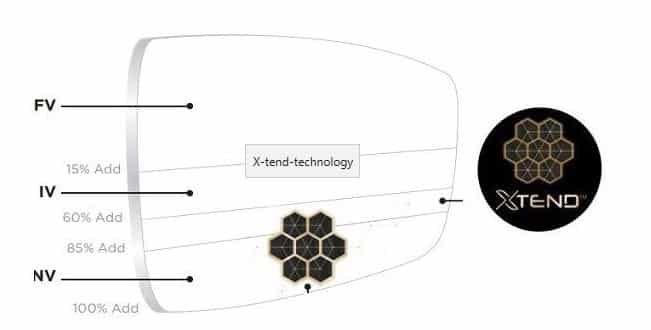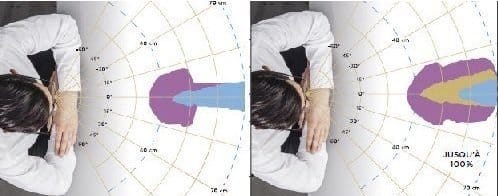Method for Measuring Near-Vision Behavior (NVB)
1) The wearer’s frame is positioned in a clip that is used to define the frame’s position in space and, by extension, the wearer’s posture and head movements
2) The wearer’s baseline far-vision position is measured in primary gaze position, using the Visioffice 2
3) The wearer grasps the tablet and gazes at the blue dot in the centre until detected by the camera; then, the movement of the target is activated, and the gaze position and movements are continuously recorded
The data records
- The NVB Point, which is the wearer’s average gaze position during the measurement, representing the wearer’s reading posture;
- The NVB Ratio distributes measurements around the NVB Point and represents the wearer’s dynamic near-vision behaviour.
X = NVB Posture
Y = NVB Behavior
Wearers data involves prescriptions, interpupillary distance, the position of the eye’s centre of rotation) and the conditions in which the lenses are worn (shape and size of the frame, lens-eye distance, pantoscopic tilt, and wrap angle) combined with the characteristics of the lenses to be produced (front and back surface design, geometry and refractive index).
The optimal position of the near-vision zone on the progressive lens is based on the wearer’s posture (as indicated by the NVB Point). Information on ametropia, prismatic effects, and binocular vision is taken into account during this stage.
The progression profile based on the wearer’s gaze dynamics, i.e. NVB Ratio, to ensure the optimum size and shape of the progressive lens zones.
The exact values for progression length and inset for the near-vision zone are arrived at by advanced calculations.
Essilor’s Research & Development mapped a graph of possible behaviours
- the horizontal axis shows the wearer’s average posture while reading, expressed as a downward gaze angle (from
12 to 30 degrees);
- the vertical axis shows near-vision behaviour, i.e., the dispersion of the gaze direction (between 0 and 1).
Thus, a wearer who adopts a sharp downward gaze while reading and primarily uses his eyes to explore his near- vision vertically will fall at the bottom-right portion of the graph. By contrast, a wearer who lowers eyes only slightly to read and primarily changes posture or moves the tablet while reading will fall at the upper left of the graph. Every kind of behaviour between these two extremes can be located on the graph.
Moreover, this mapping process includes a colour code; there is a significant effect on the optical design of the lens only if the eye can differentiate the colour codes for the two measurements. This offers an immediate way to verify that the measurements are reproducible.
Thanks to large wearer studies, each wearer’s behaviour is reproducible and represents an appropriate datapoint for customization since it is specific to each individual and differentiating.
• Near-Vision Behavior (NVB) personalization aims to ensure lenses are designed and tailored as closely as possible to the wearer’s specific posture and behaviour during near vision work.
• NVB technology is the perfect complementary feature to the Varilux X series lenses, providing the ultimate personalization tailored to the wearer’s needs.
• The process involves two phases: first, the individual’s postural behaviour must be measured and analyzed; second, a personalized design must be computed.


